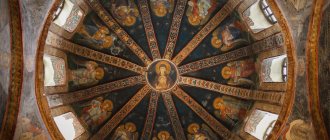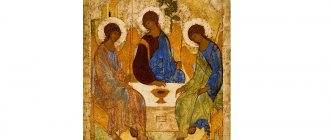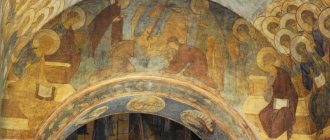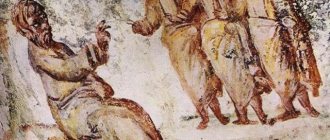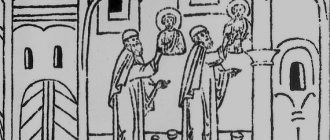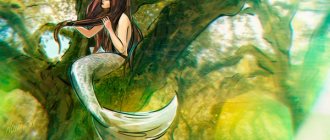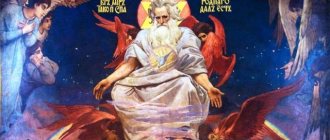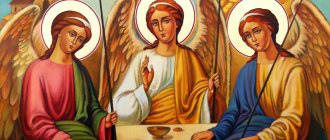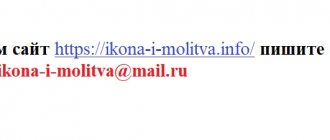Description
The icon is a board in a vertical format. It depicts three angels sitting at a table on which stands a bowl with the head of a calf. The background features a house (the chambers of Abraham), a tree (the oak of Mamre) and a mountain (Mount Moriah). The figures of angels are arranged so that the lines of their figures form a kind of closed circle. The compositional center of the icon is the bowl. The hands of the middle and left angels bless the cup. There is no active action or movement in the icon - the figures are full of motionless contemplation, and their gaze is directed to eternity. On the background, on the margins, halos and around the bowl there are repaired traces of the nails of the frame.
Iconography
The icon is based on the Old Testament story “The Hospitality of Abraham”, set out in the eighteenth chapter of the biblical book of Genesis. It tells how the forefather Abraham, the ancestor of the chosen people, met three mysterious wanderers near the oak grove of Mamre (in the next chapter they were called angels). During a meal in Abraham's house, he was given a promise about the coming miraculous birth of his son Isaac. According to the will of God, from Abraham a “great and strong nation” was to come, in which “all the nations of the earth will be blessed.” Then two angels went to destroy Sodom, a city that had angered God with the numerous atrocities of its inhabitants, and one stayed with Abraham and talked with him.
In different eras, this plot received different interpretations, but by the 9th-10th centuries the prevailing point of view was that the appearance of three angels to Abraham symbolically revealed the image of the consubstantial and trinitarian God - the Holy Trinity.
It was the Rublev icon, as scientists currently believe, that best corresponded to these ideas. In an effort to reveal the dogmatic doctrine of the Holy Trinity, Rublev abandons the traditional narrative details that were usually included in depictions of the Hospitality of Abraham. There is no Abraham, Sarah, there is no scene of the slaughter of the calf, the attributes of the meal are reduced to a minimum: the angels are presented not eating, but talking. “The angels’ gestures, smooth and restrained, testify to the sublime nature of their conversation.” In the icon, all attention is focused on the silent communication of the three angels.
“The form that most clearly expresses the idea of the consubstantiality of the three hypostases of the Holy Trinity in Rublev’s icon is the circle - it is this that is used as the basis of the composition. Moreover, the angels are not inscribed in a circle - they themselves form it, so that our gaze cannot dwell on any of the three figures and remains, rather, within the space that they limit themselves. The semantic center of the composition is a bowl with the head of a calf - a prototype of the sacrifice of the cross and a reminder of the Eucharist (a silhouette reminiscent of a bowl is also formed by the figures of the left and right angels). A silent dialogue of gestures unfolds around the bowl standing on the table.”
The left angel, symbolizing God the Father, blesses the cup - however, his hand is at a distance, as if he is passing the cup to the central angel, who also blesses it and accepts it, expressing his agreement by tilting his head: “My Father! If possible, let this Cup pass from Me; however, not as I will, but as You will” (Matthew 26:39).
The properties of each of the three hypostases are also revealed by their symbolic attributes - house, tree, mountain. The starting point of the divine economy is the creative will of God the Father, and therefore, above the angel symbolizing Him, Rublev places an image of the chambers of Abraham. The Mamvrian oak is reinterpreted as the tree of life and serves as a reminder of the Savior’s death on the cross and His resurrection, which opens the way to eternal life. It is in the center, above the angel symbolizing Christ. Finally, the mountain is a symbol of the rapture of the spirit, that is, the spiritual ascent, which is carried out by saved humanity through the direct action of the third hypostasis of the Trinity - the Holy Spirit (In the Bible, the mountain is an image of the “rapture of the spirit”, that is why the most significant events take place on it: on Sinai Moses receives the tablets of the covenant, the Transfiguration of the Lord takes place on Tabor, the Ascension on the Mount of Olives).
The unity of the three hypostases of the Holy Trinity is a perfect prototype of all unity and love - “That they all may be one, just as You, Father, are in Me, and I in You, so that they also may be one in Us” (John 17:21). The contemplation of the Holy Trinity (that is, the grace of direct communion with God) is the cherished goal of monastic asceticism, the spiritual ascent of Byzantine and Russian ascetics. The doctrine of the communicability of divine energy as a path to spiritual restoration and transformation of man has made it possible to understand and formulate this goal in the best possible way. Thus, it was precisely the special spiritual orientation of Orthodoxy of the 14th century (which continued the ancient traditions of Christian asceticism) that prepared and made possible the appearance of Andrei Rublev’s “Trinity”.
Salaries
In 1575, as the records of the Trinity-Sergius Lavra testify, the icon was “overlaid with gold” by Ivan the Terrible. In 1600, it was re-decorated with a precious frame by Tsar Boris Godunov. The former gold salary of Ivan the Terrible was transferred from it to a copy specially written for this purpose. The new frame repeated the composition of the frame of Ivan the Terrible.
In 1626, Tsar Mikhail Fedorovich gave gold tsats with enamels and precious stones for the icon. In the 18th century, silver and gilded chased vestments (robes of angels) were placed on the icon. The current location of the salary is the Sergiev Posad State Museum-Reserve.
Lists
According to the canons of Orthodoxy, a consecrated copy-list, in moderation and similarity to the image, completely replaces the icon of the ancient letter.
- A copy of Godunov, ordered by the Tsar in 1598-1600 in order to transfer the golden robe of Ivan IV from the original icon, replacing it with his own. It was placed on the left side of the “royal doors” of the cathedral in the same local row.
- Copy of Baranov and Chirikov 1926-28. for the international restoration exhibition of icons in 1929. Placed in the iconostasis instead of the original, transported to the Tretyakov Gallery in 1929. Consecrated in 1948.
Both icons are today placed in the iconostasis of the Trinity Cathedral of the Trinity-Sergius Lavra, where the icon itself was located until it was moved to the Tretyakov Gallery.
The uniqueness of the image of “Trinity” by Rublev
A person cannot rationally explain Christian dogmas, cannot describe the concept of the Holy Trinity - this is a great mystery inaccessible to the common man. Andrei Rublev lifts the veil of this mystery and gives believers the opportunity to look at this issue from a different angle. The reflection of each gesture, the turn of the head, the elements of the ornament - all this carries a deep meaning and gives a person the opportunity to “see the invisible”, although it eludes our mind.
What is unique about the Trinity icon by Andrei Rublev? Before the creation of this image, icon painters traditionally depicted the plot of the eighteenth chapter of the book of Genesis in a slightly different way: the main theme was the hospitality of Sarah and Abraham, into whose house three angels appeared. Andrei Rublev decided to focus specifically on the angels themselves, since, based on the content of this chapter, it becomes clear that God Himself appeared to Sarah and Abraham that evening. The icon is also unusual in that its meaning is multifaceted, and the very content of the image can be interpreted in different ways.
History of icons in the 16th–19th centuries
Sources
Historical information about the history of the creation of Rublev’s “Trinity” is scarce and therefore, even at the beginning of the 20th century, researchers did not dare to assert anything and expressed only assumptions and guesses. For the first time, the icon “Trinity” in Andrei Rublev’s letter is mentioned by the resolution of the Stoglavy Cathedral (1551), which concerned the iconography of the Trinity and the canonically necessary details of the image (crosses, halos and inscriptions) and consisted in the following question submitted for discussion:
| “Chapter MA, question A: For the holy trinity they write crosshairs, ovi for the middle one, and others for all three, and in the old letters and in Greek they sign the holy trinity, and crosshairs are not written for any of them, but now they sign for the middle one IC XC holy Trinity, and judge about that from the Divine rules, how to write it now. The answer is: An icon painter should paint icons from ancient translations, as the Greek icon painters wrote, and as Ondrei Rublev and other notorious icon painters wrote, and sign the Holy Trinity, and do nothing from his plans.” |
Thus, from this text it follows that the participants of the Stoglavy Council knew about a certain icon of the Trinity, painted by Rublev, which, in their opinion, fully corresponded to the church canons and could be taken as a model.
The next source containing information about Rublev’s painting of the Trinity icon is “The Tale of the Holy Icon Painters,” compiled at the end of the 17th - beginning of the 18th century. It includes many semi-legendary stories, including the mention that Nikon of Radonezh, a disciple of St. Sergius of Radonezh, asked Rublev “to paint an image of the Most Holy Trinity in praise of his father Sergius.” Obviously, this late source is perceived by most researchers as insufficiently reliable.
The generally accepted version of the creation and the problem of dating the icon
According to the currently generally accepted version, based on church tradition, the icon was painted “in praise of Sergius of Radonezh” by order of his student and successor, Abbot Nikon.
The question of exactly when this could have happened remains open.
In 1411, immediately after the invasion of Edigei, when the original wooden Trinity Church burned down, Nikon of Radonezh, the successor of Sergius, built a new wooden church. And by 1425, the stone Trinity Cathedral was built, which has survived to this day.
It is believed that Abbot Nikon, who became rector after the death of St. Sergius, anticipating his imminent death, invited the artel of Andrei Rublev and Daniil Cherny to complete the decoration of the newly built white-stone Trinity Cathedral. Icon painters had to paint the temple with frescoes and also create a multi-tiered iconostasis. But neither the Life of Sergius nor the Life of Nikon says a word about the Trinity icon - it only talks about the decoration of the cathedral in 1425-1427.
It is assumed that it was possible to begin painting the cathedral walls, erected thanks to the order and funds of Prince Yuri Dmitrievich Zvenigorodsky, only a year after its construction, when the building settled. Therefore, it is believed that the masters began creating icons.
Thanks to the correlation of church tradition with information about the construction of the Trinity Cathedral, two versions arose about the dating of the “Trinity”. The question is which temple icon of which cathedral it was:
- early, wooden, which was built in 1411. In this case, the icon of the Trinity was transferred from the wooden church to the new cathedral.
- or the second, stone, built in 1425-27, when the entire iconostasis that has survived to this day was created.
Thus, the Trinity has only two possible dates of creation. Usually in the most academic publications both dates are given through the word “or”: 1411 or 1425-27.
This dating is based on information about the years of construction of the cathedrals. However, art historians, considering the icon from the point of view of style, do not consider this issue to be completely resolved. I. E. Grabar carefully dated the “Trinity” to 1408-1425, Yu. A. Lebedev - 1422-1423, V. I. Antonov - 1420-1427. The dating of the icon depends on whether we consider it as a work from the heyday of Rublev’s work or from his late period. In its style, the icon cannot be separated by a large interval from the paintings of the Assumption Cathedral of 1408. On the other hand, it is much more solid in design and more perfect in execution than the best of the icons of the Trinity Cathedral, which arose between 1425 and 1427, and the heyday of Rublev’s work was 1408-1420, and by no means 1425-1430.
Plugin version
The Soviet historian and source scientist V. A. Plugin put forward a different version about the life path of the icon. In his opinion, it was not written by Rublev for the Trinity Church by order of Nikon of Radonezh, but was brought to the Lavra by Ivan the Terrible. In his opinion, the mistake of previous researchers is that they, following the famous historian A.V. Gorsky, believe that Ivan the Terrible only “dressed” an existing image with a golden robe. Plugin reads the entry in the deposit book of 1673, reproducing the records of the registered vestry books of 1575, it is directly stated: “The Sovereign Tsar and Grand Duke Ivan Vasilyevich of All Russia, the contribution is written in the registered vestry books of the year 83 [1575] <...> the image of the local of the life-giving Trinity, overlaid with gold, the crowns are gold,” etc. - that is, according to the scientist, Ivan the Terrible invested not only the frame, but the entire icon. Plugin believes that the tsar donated to the monastery where he was baptized an icon of Rublev (to whom it was not yet attributed), painted for some other place where it had been located for the previous 150 years.
However, in 1998, B. M. Kloss drew attention to information from the so-called Trinity Tale of the Capture of Kazan, created before June 1553, which definitely indicates that the icon is not the contribution of Ivan the Terrible, but was only “decorated” by the Tsar. Thus, V.A. Plugin’s hypothesis turned out to be untenable.
Authorship and style
For the first time, as scientists know, Rublev was named as the author of the “Trinity” in the middle of the 16th century in the materials of the Stoglavy Cathedral - that is, in the middle of the 16th century we can already say with confidence that Rublev was considered the author of such an icon. By 1905, the idea, which came from the light hand of I.M. Snegirev, that the icon in the Trinity-Sergius Lavra belongs to the brush of Andrei Rublev, one of the few Russian icon painters known by name, was already dominant. At the moment it is dominant and generally accepted.
However, after the icon was uncovered from cleaning, researchers were so amazed by its beauty that versions arose that it was created by a master who came from Italy. The first who, even before the opening of the icon, put forward the version that the “Trinity” was painted by an “Italian artist” was D. A. Rovinsky, whose opinion “was immediately extinguished by a note from Metropolitan Philaret, and again, on the basis of legend, the image was classified as Rublev’s works, continuing to serve as one of the main monuments in the study of the manner of this icon painter.” The “Trinity” was compared with Giotto and Duccio by D. V. Ainalov, N. P. Sychev and later N. N. Punin; with Piero della Francesca - V.N. Lazarev, although their opinion should rather be attributed to the highest quality of painting, and not directly interpreted as a version that the icon was created under the influence of the Italians.
But Lazarev sums up: “In the light of the latest research, it can definitely be said that Rublev did not know the monuments of Italian art, and therefore could not borrow anything from them. Its main source was Byzantine painting of the Palaiologan era, and, moreover, capital, Constantinople painting. It was from here that he drew the elegant types of his angels, the motif of bowed heads, and the rectangular table.”
Icon in the Lavra
According to the archives of the monastery, since 1575, after the acquisition of the frame of Ivan the Terrible, the icon occupied the main place (to the right of the royal doors) in the “local” row of the iconostasis of the Trinity Cathedral of the Trinity-Sergius Lavra. It was one of the most revered icons in the monastery, attracting rich contributions first from Ivan IV and then from Boris Godunov and his family. The main shrine of the Lavra, however, remained the relics of Sergius of Radonezh.
Until the end of 1904, Rublev’s “Trinity” was hidden from the eyes of curious people with a heavy golden robe, leaving only the faces and hands of the angels exposed.
How to pray in front of an icon
Home appeal to the Holy Trinity is associated with compliance with basic rules:
- they prepare for prayers in advance; for newly converted Orthodox Christians, it is permissible to use prayer books with texts;
- for requests, choose early morning, before starting work, or early evening, before dinner;
- To pray, be sure to observe solitude and focus on your thoughts.
History of the icon in the 20th century
Walter Benjamin, who visited Russia in 1926, wrote about him: “...and the neck and arms, when the frame covers the icon, appear as if in massive chains, so that the angels are somewhat reminiscent of Chinese criminals sentenced for their atrocities to stay in metal stocks.” .
Background to the clearing
At the turn of the 19th and 20th centuries, Russian icon painting as an art was “discovered” by representatives of Russian culture, who discovered that the quality of this artistic movement was not inferior to the best world movements. The icons began to be removed from their frames, which covered them almost completely (with the exception of the so-called “personal letter” - faces and hands), and also to be cleared. Cleaning was necessary, since icons were traditionally covered with drying oil. “The average period for complete darkening of drying oil or oil-resin varnish ranges from 30 to 90 years. On top of the darkened covering layer, Russian icon painters painted a new image, as a rule, matching the plot, but in accordance with the new aesthetic requirements imposed by time. In some cases, the restorer strictly followed the proportions and principles of compositional structure of the original source, in others he repeated the plot, making amendments to the original image: he changed the sizes and proportions of the figures, their poses, and other details” - the so-called renovation of icons.
Trinity Updates
The Trinity has been renewed four or five times since at least 1600:
- Its first renovation dates back, apparently, to Godunov.
- Next, most likely, by 1635, when all the monumental painting and iconostasis of the Trinity-Sergius Lavra were renewed, and taking into account the nature of the renovations of monumental painting, we can assume that it was at this time that the “Trinity” icon was barbarously sanded and those losses of colorful The layers we have today - for example, on the clothes of the angels and on the background - are the result of this renewal.
- Then it was renewed in 1777 under Metropolitan Plato during the same alteration of the Trinity iconostasis
- Then twice, according to information provided by Guryanov, in the 19th century: in 1835 and in 1854-55 - by the Paleshans, as well as by the artist I. M. Malyshev.
Clearing of 1904
At the beginning of the 20th century, icons were cleared one after another, and many of them turned out to be masterpieces that delighted researchers. Interest also arose in the “Trinity” from the Lavra. Although, unlike, for example, the Vladimir or Kazan icons, it did not enjoy colossal veneration among believers, did not perform miracles - it was not “miraculous”, did not stream myrrh and did not become the source of a large number of lists, nevertheless, it enjoyed a certain reputation - mainly , due to the fact that they believed that this image was the same one that “Stoglav” pointed to, since no other “Trinities” ordered by Rublev were known. It is important to mention that, due to its mention in Stoglav, the name of Rublev as an icon painter (as if his “canonization” as an artist) was highly revered among believers, and therefore many icons were attributed to him. “The study of the Trinity could provide art historians with a kind of reliable standard, by reference to which it would be possible to obtain a comprehensive understanding of the style and working methods of the famous master. At the same time, this data would make it possible to carry out an examination of other icons that were attributed to Andrei Rublev on the basis of legend or popular opinion.”
At the invitation of the father-vicar of the Trinity-Sergius Lavra, in the spring of 1904, the icon painter and restorer V.P. Guryanov took the icon out of the iconostasis, removed the gold chased frame from it, and then for the first time freed the “Trinity” icon from later records and blackened drying oil. Guryanov was invited on the advice of collector I. S. Ostroukhov, the restorer was assisted by V. A. Tyulin and A. I. Izraztsov.
As it turned out, the last time the “Trinity” was updated (that is, “restored” according to the concepts of ancient icon painters, recording again) was in the middle of the 19th century. When removing the frame from it, Guryanov saw, of course, not Rublev’s painting, but a continuous record of the 19th century, under it there was a layer of the 18th century from the time of Metropolitan Plato, and the rest, perhaps some fragments of other times. And already under all this lay Rublev’s painting.
| When the golden robe was removed from this icon,” writes Guryanov, “we saw an icon completely written down... On it the background and margins were sankir, brown, and the gold inscriptions were new. All the angels' clothes were rewritten in a lilac tone and whitewashed not with paint, but with gold; the table, the mountain and the chambers were rewritten again... Only the faces remained, by which one could judge that this icon was ancient, but they were also shaded in the shadows with brown oil paint. |
When V.P. Guryanov, having removed three layers of strata, the last of which was made in the Palekh manner, discovered the author’s layer (as it turned out during the repeated restoration in 1919, in some places he did not reach it), both the restorer himself and eyewitnesses to his discovery experienced a real shock. Instead of the dark, “smoky” tones of the dark olive swirl of faces and the restrained, severe brown-red range of clothes, so familiar to the eye of a connoisseur of ancient Russian icon painting of that time, bright sunny colors, transparent, truly “heavenly” clothes of angels, immediately reminiscent of Italian ones, were revealed to the amazed spectators frescoes and icons of the 14th century, especially the first half of the 15th century.
Having removed the layers of late painting, Guryanov recorded the icon anew in accordance with his own ideas about what this icon should look like (the restorers of the Silver Age were still very archaic). After this, the icon was returned to the iconostasis.
Researchers write about the clearing and restoration of Guryanov, which later had to be liquidated: “Actually, restoration in the modern scientific understanding of the word can be called (but not without some reservations) only the opening of the monument, carried out in 1918; all previous work on “Trinity”, in fact, were only its “renewals,” not excluding the “restoration” that took place in 1904-1905 under the leadership of V.P. Guryanov. (...) There is no doubt that the restorers of the icon deliberately strengthened, in fact, its entire graphic-linear structure - with a rough forcing of the contours of figures, clothes, halos, and even with obvious interference in the “holy of holies” - in the area “ personal letter,” where the author’s incomplete and probably poorly preserved “inventory” of faces and “drawing” of their features (already quite schematically reproduced by later renovations of the 16th–19th centuries) were literally dented and absorbed by the rigid graphics of V.P. Guryanov and his assistants."
Clearing of 1918
As soon as the icon got back into the iconostasis of the Trinity Cathedral, it quickly darkened again and had to be opened again. In 1918, under the leadership of Count Yuri Olsufiev, a new restoration of the icon began. This disclosure was started on the initiative and carried out on the instructions of the Commission for the Discovery of Ancient Painting in Russia, which included such prominent figures of national culture as I. E. Grabar, A. I. Anisimov, A. V. Grishchenko, K. K Romanov, and the Commission for the Protection of Art Monuments of the Trinity-Sergius Lavra (Yu. A. Olsufiev, P. A. Florensky, P. N. Kapterev). Restoration work was carried out from November 28, 1918 to January 2, 1919 by I. I. Suslov, V. A. Tyulin and G. O. Chirikov. All successive stages of the disclosure of the “Trinity” were reflected in very detailed detail in the restoration “Diary”. Based on the records available in it, as well as, probably, his personal observations, Yu. A. Olsufiev, much later, already in 1925, compiled a consolidated “Protocol No. 1” (all these documents were preserved in the Tretyakov Gallery archive and were published in the article Malkova in the “Museum”).
| Wednesday, November 14th (27th), 1918 O. Chirikov cleared the face of the left angel. Part of the left cheek along the edge, from the eyebrow to the end of the nose, turned out to be missing and repaired. The repair has been stopped. The entire strand of hair falling on the left side was also lost and mended. Part of the outline, thin and wavy, has been preserved. Chink left. Part of the hair at the top of the curly coifure and a blue ribbon among the curls above the forehead are lost along the edge. The hair at the top of the head was done partly in 1905, partly earlier; the repair was left (...) In the evening G.O. Chirikov, I.I. Suslov and V.A. Tyulin cleared the golden background of the icon and halos of angels. The gold is largely lost, as is the rumors of the angels, of which only the count remains. Only parts of some letters have survived from the cinnabar inscription. On the background, in some places, new putty was discovered (“Restoration Diary”).” |
Problems with the safety of the Trinity began immediately after its discovery in 1918-19. Twice a year, in spring and autumn, when the humidity in the Trinity Cathedral increased, the icon was transferred to the so-called First Icon Reserve, or chamber. Such changes in temperature and humidity conditions could not but affect her condition.
Trinity Simon Ushakova
No less important for the Orthodox is the icon painted by Simon Ushakov, known as the “Old Testament Trinity.”
It is noteworthy that the angels are depicted on it in the form of primitive portraits rather than iconographic images, and the central character on it looks directly at the viewer, unlike Rublev’s icon. The icon has a more secular character, since Ushakov was the first icon painter to use Western European painting techniques. His “Old Testament Trinity” is the second most famous after the icon of Andrei Rublev.
Found a violation? Report content
Icon in the museum
Until the October Revolution, the “Trinity” remained in the Trinity Cathedral of the Trinity-Sergius Lavra, but then, by order of the Soviet government, it was transferred for restoration to the newly established Central State Restoration Workshops.
The Decree of the Council of People's Commissars of April 20, 1920 “On the appeal to the museum of historical and artistic values of the Trinity Lavra of St. Sergius” transferred its ensemble and collections to the jurisdiction of the People's Commissariat of Education “in order to democratize artistic and historical buildings, by turning these buildings and collections into a museum "
Andrei Rublev's Trinity icon entered the collection of the State Tretyakov Gallery in 1929. It came from the Zagorsk Historical and Art Museum-Reserve (Sergiev Posad Museum). Instead of the 500-year-old original, a list made by Nikolai Andreevich Baranov was placed in the iconostasis. And it was finally revealed in the Tretyakov Gallery by Baranov.
The icon left the walls of the State Tretyakov Gallery only in 1941 during the evacuation during World War II to Novosibirsk, where the gallery exhibits were housed in the building of the Opera House. October 9, 1944 - an order for re-evacuation was issued. May 17, 1945 - “Trinity” is again exhibited in the halls of the Tretyakov Gallery that reopened after renovation. In May 2007, “Trinity” was taken to the Tretyakov Gallery building on Krymsky Val for the exhibition “Europe - Russia - Europe”. After this, despite the fact that the movement took place within the Garden Ring, the problematic piece of the board shifted (see below) and had to be strengthened.
Since 1997, every year on the feast of Trinity, the icon (“very carefully, in her arms,” according to the keeper) is transferred to the temple-museum at the State Tretyakov Gallery, where it is provided with the proper museum temperature and humidity conditions, where the icon is located in a special display case. The intention to transfer Rublev’s “Trinity” to the diocese first arose from Boris Nikolaevich Yeltsin. Academician Yanin, with the assistance of the then Minister of Culture Melentyev, obtained a reception from Yeltsin and convinced him to abandon this idea. The matter then ended with a government decree published in the Rossiyskaya Gazeta, according to which the Trinity was forever declared to belong to the Tretyakov Gallery.
Preservation and current state of the icon
In the form in which we now see the “Trinity”, it has not been in the Trinity-Sergius Lavra since at least 1600 (before the first entry), and most likely even earlier. The monument, which for centuries was in liturgical use in the Trinity-Sergius Lavra, did not at all resemble the icon of the 15th century. The closest approach to the state of the 15th century became possible only after the restoration of 1918. However, during the restoration of Olsufiev, numerous notes by Guryanov and those notes that Guryanov himself were also left were left; the pictorial surface of the icon today is a combination of layers of painting from different times.
Measure of the icon: width 112 centimeters, height 139 cm, thickness of the board 3 cm, width of the bottom field - 7 cm, width of the sides - 5.2 cm, width of the top - 6.5 cm, depth of the ark recess - 1 cm. Icon weight 27. 3 kg. The icon shield of the “Trinity”, that is, the base on which the icon is written, consists of five boards wide (from left to right - along the back side): the first - in the upper part - 29 cm, in the lower part - 30.5 cm; the second - 20.2 cm and 19.2 cm, respectively; third - 23.3 cm and 26.2 cm; fourth - 26.3 cm and 22.4 cm; fifth - 11.7 cm and 12.4 cm; Moreover, between the third and fourth boards there is an insert of two planks. The boards are glued (“knocked down”) and also connected with dowels - a kind of wedges. A full description of all the dents, cracks and imperfections in the paint layer of the icon is published in Malkov’s article in the “Museum” and takes 3 pages.
On November 10, 2008, a meeting of the expanded restoration council was held, at which the state of preservation of the icon was discussed and at which the question was raised about the possibility of strengthening the base of the icon. At this Council it was decided that under no circumstances should one interfere with the established, stable state of the monument. On the back, it was decided to put beacons to monitor the condition of the base.
Quotes from the “Transcript of the extended restoration meeting at the State Tretyakov Gallery on the issue of Rublev’s “Trinity””:
| Today, the state of preservation of the icon, which is about 580 years old, is stable, although there are chronic lags in the soil with the paint layer, mainly in the margins of the icon. The main problem of this monument: a vertical crack running through the entire front surface, which occurred as a result of the rupture of the first and second base boards. This problem arose most acutely in the spring of 1931, when, as a result of an inspection of the state of preservation, breaks in the soil with the paint layer on the front side of the icon, breaks in the pavolok and a fairly large discrepancy were discovered. On the front side in the upper part of the icon along this crack the discrepancy reached two millimeters, on the face of the right angel - about one millimeter. The icon is fastened with two counter keys, and also the first and second boards are fastened with two “swallows”. After the discovery of such a condition in 1931, a protocol was drawn up, in which it was noted in detail that this gap was not associated with falls of soil and paint layer and the cause of this gap was the old problems of this icon. This crack was recorded after the clearing of the icon by Guryanov in 1905 (there is a photograph where this crack is present). In 1931 the problem came to light. Then the expert of the Central State Restoration Workshops Olsufiev proposed a method to eliminate this discrepancy: the icon was transferred to a special room where a fairly high humidity was artificially maintained (about 70%), and where the boards were under constant observation and constant recording of the dynamics of this convergence for almost a month and a half. agreed. By the summer of 1931, the boards on the front side almost converged, but then it was noted that the convergence was no longer so dynamic, and as a result of the study it was discovered that the middle key rests with its wide end against the edge of the first board and prevents the complete convergence of the base boards. As a result, in 1931, the restorer Kirikov cut off the protruding end of the middle key, which was interfering with the convergence of the boards, and already in 1932, since no unanimity was reached in the discussion throughout the year, it was decided to strengthen the lagging gesso with a paint layer on the front side using gluten (this is a wax-resin mastic) and also fill the crack on the back with a mastic composition, which should serve as protection for the sides of the separated boards from atmospheric influences, but at the same time could not hold it together. In addition, researchers do not know how different layers of painting will behave at the slightest change in some conditions, or how destructive any changes in temperature and humidity conditions can be. A crack along which minimal movements occur; they are fixed with an adhesive composition, which, nevertheless, moves back and forth. Minimal, but walks. The slightest climate change could lead to this movement becoming much more serious. |
Request to transport the icon to the Lavra
On November 17, 2008, another extended restoration meeting took place at the State Tretyakov Gallery, after which on September 19, 2008, senior researcher at the Tretyakov Gallery Levon Nersesyan reported on his blog about the request of Patriarch Alexy II to provide the “Trinity” to the Trinity-Sergius Lavra for three days for participation in church holiday in the summer of 2009. Moving the icon to the Lavra, its stay for three days in the microclimate of the cathedral, among candles, incense and believers, and then transporting it back to the State Tretyakov Gallery, according to museum experts, can destroy it. The information published by Nersesyan had a great public response and caused many publications in the media. The only museum employees who were in favor of providing the icon were the director of the Tretyakov Gallery and its chief curator, while most other employees who were not such high officials, as well as art historians and scientists working in other institutions, spoke out sharply against it and accused the director and the custodian with the intention of committing a “malfeasance” that will lead to the loss of national property.
| “Trinity” is an outstanding cultural monument, a national treasure, which people of all views, regardless of their religious affiliation, should become acquainted with. It is customary to store outstanding cultural monuments not in churches, where they are seen by a narrow circle of parishioners, but in public museums. — Academician V.L. Ioannina |
At the moment, the “Trinity” is stored in the hall of ancient Russian painting at the Tretyakov Gallery, in a special glass cabinet in which constant humidity and temperature are maintained, and which protects the icon from any external influences.
On the Trinity Day of 2009, after an active discussion in the press and a letter to the president, signed by many cultural figures and ordinary citizens, and also, most likely, under the influence of other factors (for example, the patriarch died on December 5, 2008), the icon remained in the Tretyakov Gallery and, as usual, it was moved to the church at the museum, from where it was later safely taken back to its place in the exhibition.
Feast of the Holy Trinity
The Day of the Holy Trinity does not have an exact date, since it is celebrated on the fiftieth day after the Resurrection of Christ and on the tenth day after his Ascension; this year this date falls on June 20.
On this day, the Holy Spirit descended on the apostles, other disciples of Christ and the Mother of God, as well as everyone who was in the house with them, in the form of tongues of flame, and all the apostles were given the power to preach.
The Holy Spirit appeared in the form of fire because it symbolized a flame capable of warming the souls of people and scorching, burning away their sins, purifying a person. There were many people in Jerusalem at that moment on the occasion of the Feast of Pentecost, and the apostles came out to them and began to preach the teachings of Christ in their native languages. About three thousand people believed in Christ and were baptized that same day. The Kingdom of God began to be established on earth.
